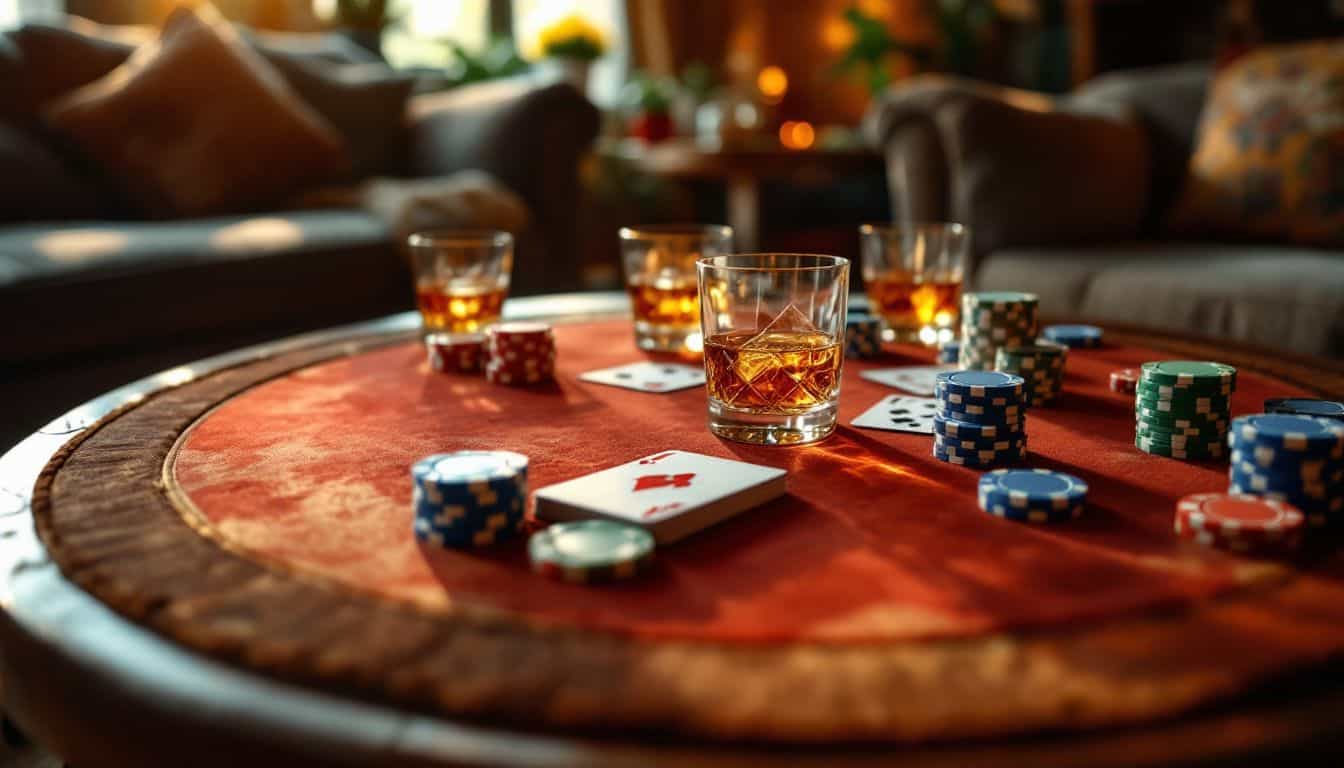Hosting a poker night can feel scary if you’ve never done it before. Most home poker games fail because people skip the basic setup steps. I’ll show you how to host the perfect poker night with nine pro casino tips that work like magic.
Get ready to throw an amazing poker party your friends won’t stop talking about.
Key Takeaways
A successful poker night needs 6–8 players, quality equipment ($30-$100 for basic sets, $100-$300 for chips), and clear house rules about buy-ins and blinds.
Start games at 7 PM and end by midnight, with blind levels starting at $5/$10 and increasing every 20–30 minutes to keep the game moving smoothly.
Create the right atmosphere with soft background jazz music, finger foods like nuts and pretzels, and a dedicated dealer to manage game flow and disputes.
Set a budget of about $200 for supplies and refreshments, with buy-ins ranging from $20-$100 depending on skill levels and stakes.
Keep players comfortable with proper seating, good lighting, and 2 feet of space per person around a sturdy table in a well-ventilated room.
Table of Contents
Planning Your Poker Night

Planning a poker night takes more than just pulling out a deck of cards and calling your friends. A solid plan needs three key parts: picking the perfect date and spot, setting your spending limit, and getting your supplies ready to roll.
Set a Date and Time
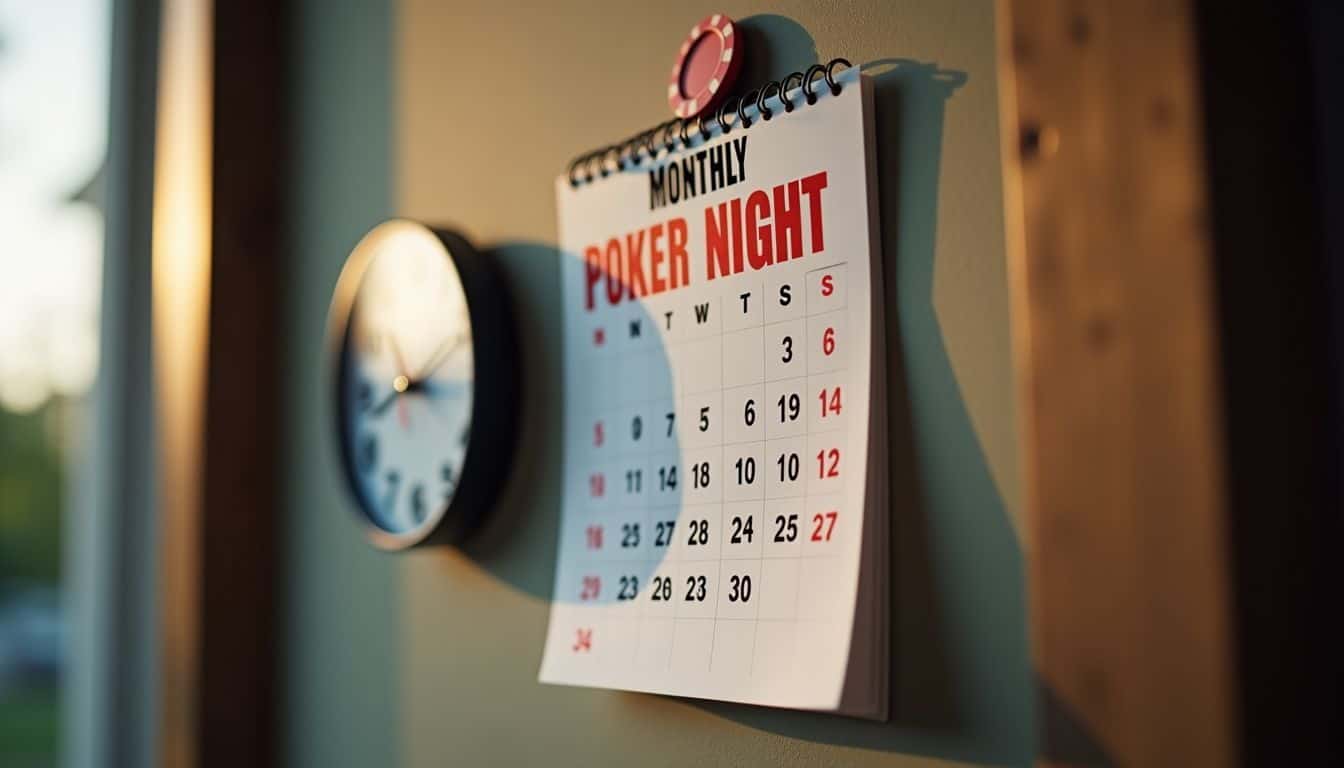
Pick a fixed date for your monthly poker night and stick to it. Your poker buddies will thank you for making it easy to plan ahead. Unlike playing poker online, getting friends together needs solid scheduling.
Mark your calendar for the same day each month, like the first Saturday or last Friday. This creates a routine everyone can count on.
https://www.youtube.com/watch?v=kugg8t-_n8s
Your start and end times matter just as much as the date. Start after dinner, around 7 PM, so everyone has time to eat and relax first. Set a clear end time too – maybe midnight or 1 AM.
This helps your guests plan their next day and keeps the game moving at a good pace. No one likes those endless games that drag into the early morning hours!
Choose a Suitable Location
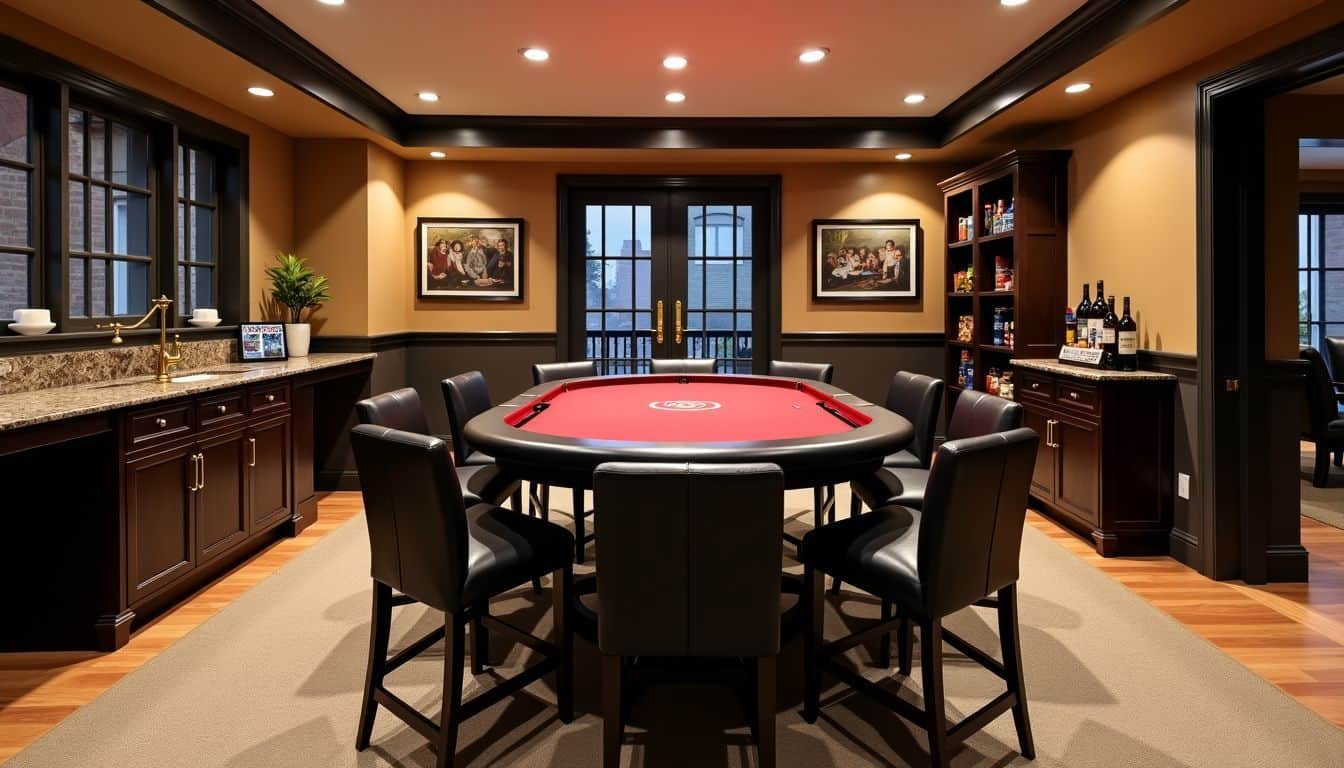
Your poker room needs plenty of space for guests to move around freely. A basement or garage works great for hosting 6–8 players at your poker table. The space must have good lighting to read cards and chips clearly.
Your dining room could work too, but make sure to protect fancy surfaces from drink spills. The right spot needs proper airflow and temperature control – nobody wants to play cards in a stuffy room.
The perfect poker room is like a well-dealt hand – everything falls right into place.
The perfect poker room is like a well-dealt hand – everything falls right into place. The ideal poker location offers easy access to bathrooms and a kitchen area for snacks and drinks. Set up your poker supplies on a sturdy table with firm, comfortable seating. Barstools work well for a casino feel, but regular chairs are fine too.
Keep noise levels down by picking a spot away from sleeping areas, especially for late-night games. A dedicated game room gives you the most control over the atmosphere and lets you leave supplies set up between games.
Determine Your Budget
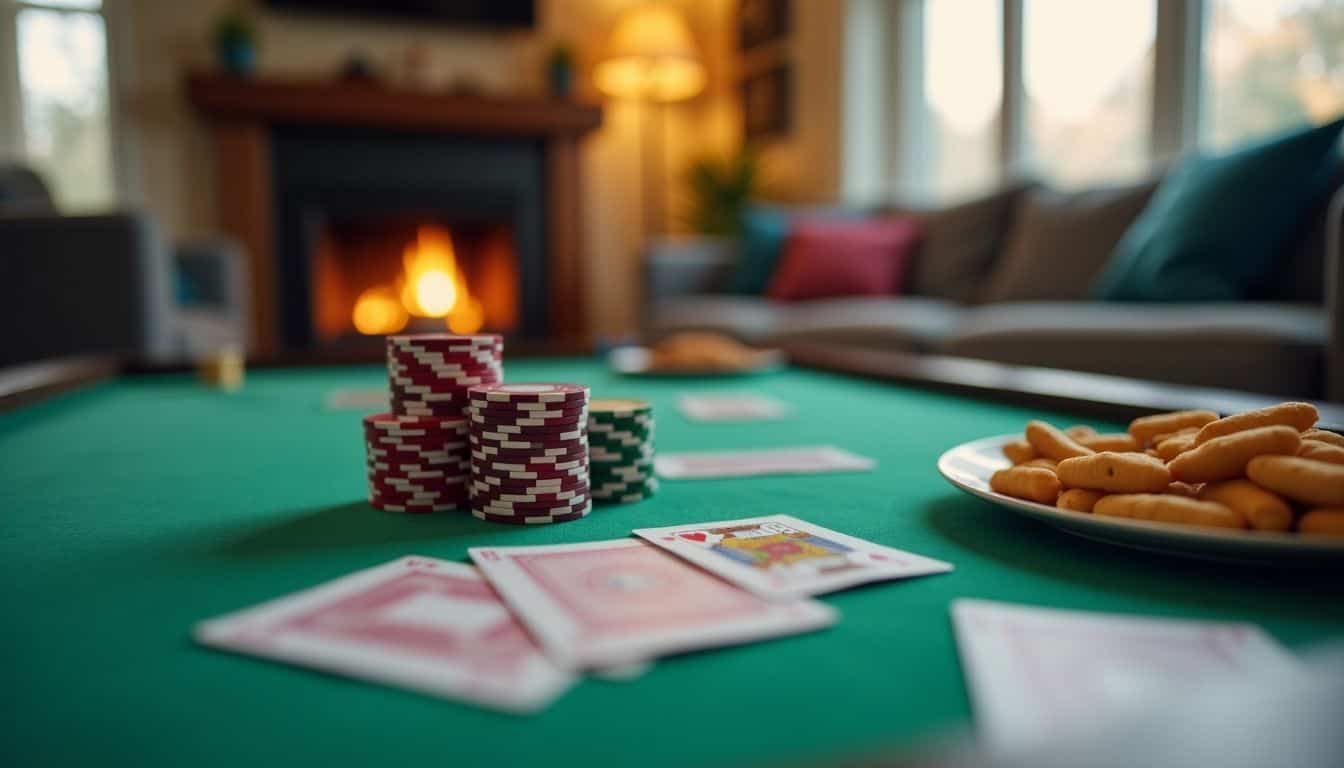
Money matters make or break a poker night. Start by setting a clear budget for poker supplies, snacks, and drinks. Most basic poker sets cost between $30 to $100, while high-quality poker chips run from $100 to $300.
Pro tip: Split costs with regular players to make the investment lighter on your wallet. Hiring a professional dealer costs extra – about $150 to $250 per night – but adds a real casino feel to your game.
Smart planning keeps the focus on fun rather than finances. Break down expenses into must-haves like cards and chips, plus nice-to-haves such as fancy snacks or themed decorations.
A basic home game needs about $200 for supplies and refreshments. Now let’s look at the essential items you’ll need for your poker setup.
Preparing the Essentials
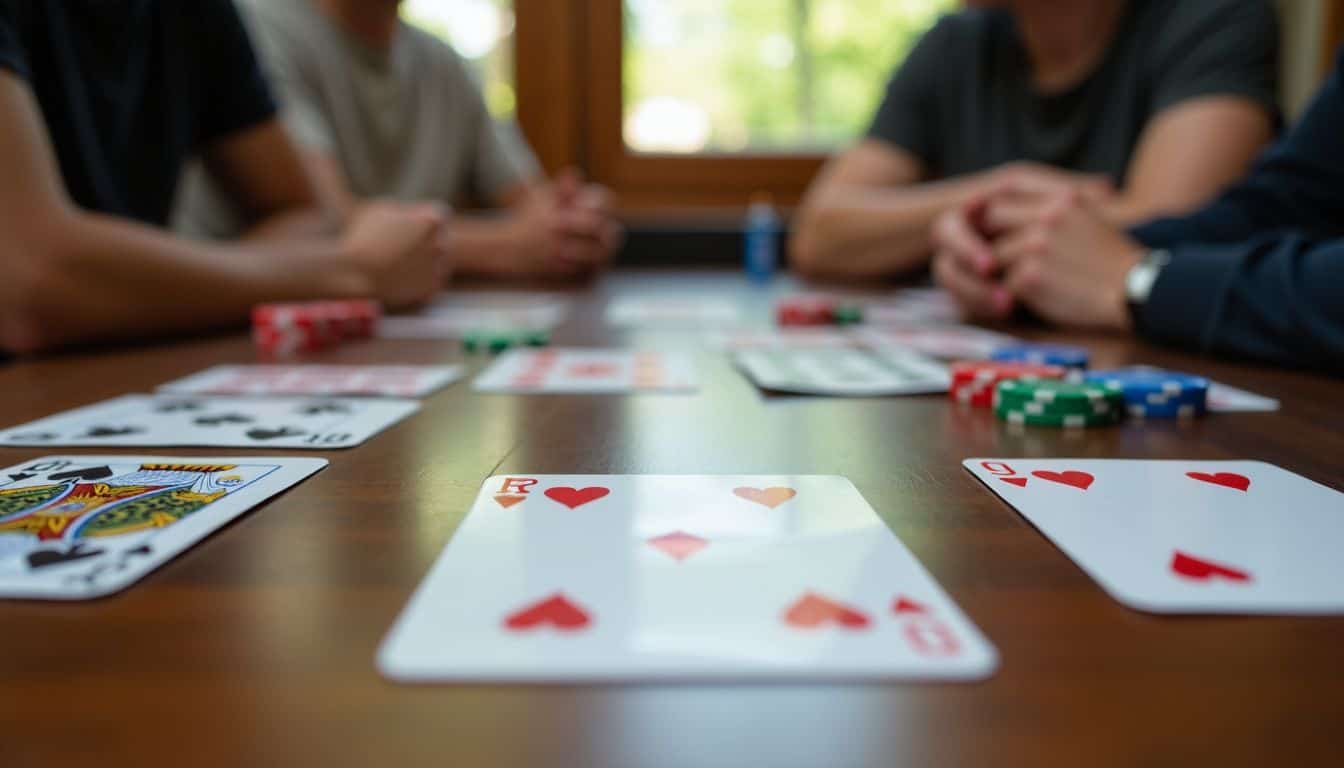
A poker night needs the right tools to make it feel like a real casino experience. You’ll want a proper table setup with quality cards and chips – these basics make the difference between a casual hangout and a pro-level game that your friends will talk about for weeks.
Poker Table or Setup
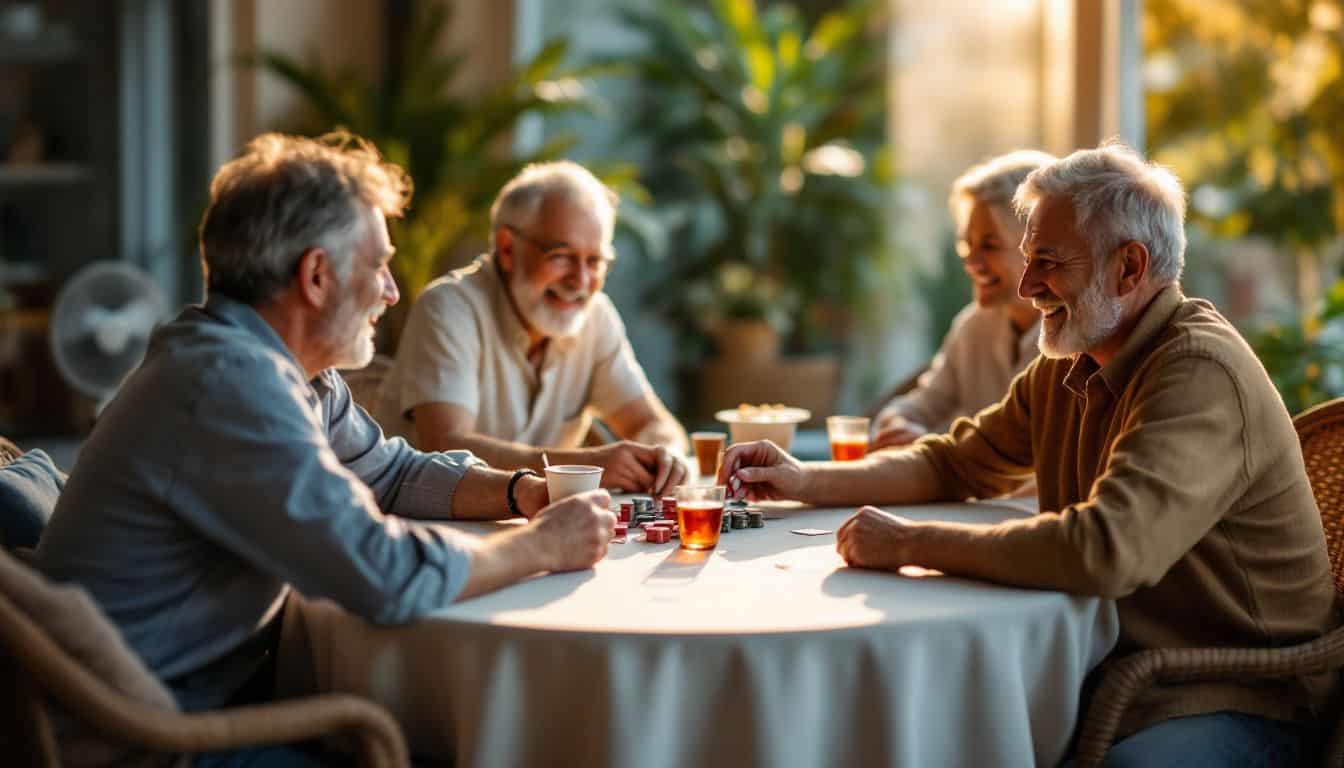
Your poker table sets the stage for an exciting night of cards and fun. The perfect setup needs good lighting right above the playing surface. You’ll want to pick a table that fits your space – a real poker table works great, but a round dining table with a soft tablecloth makes a nice substitute.
Make sure your guests can see their cards and chips clearly without harsh shadows getting in the way.
The right temperature keeps everyone comfortable during long games. Place fans nearby to keep air moving, especially if you’ve got a full table of players. Your setup should include spots for drinks and snacks within easy reach.
Small side tables work perfectly for this. The dealer button needs to move smoothly around the table, so leave enough elbow room between seats. Good lighting and cozy temps will keep your poker party rolling smoothly all night long.
Playing Cards and Chips
Quality cards and chips make a huge difference in your poker night’s success. I learned this the hard way after hosting dozens of games with flimsy cards that bent and cheap chips that broke.
Now, I stick to durable plastic playing cards with clear designs – they resist spills and last longer than paper ones. Two decks help keep the game moving while one gets shuffled. For chips, invest in a set made of clay or composite material, with 50–75 chips per player.
These weightier chips feel great to handle and stack nicely, just like in real casinos.
Good poker is about playing the player, but great poker starts with the right equipment. – Annie Duke
The colors of your chips should match standard casino values – white ($1), red ($5), green ($25), and black ($100). This setup helps players track their stacks and makes betting smoother.
A card shuffler speeds things up, though many pros prefer hand-shuffling for better control. I keep my cards and chips in a padded case between games to prevent damage. The right tools turn an ordinary game into a pro-level experience that your guests will talk about for weeks.
Comfortable Seating
Now that you’ve got your cards and chips ready, let’s focus on keeping your guests happy during long poker sessions. Your players need proper seating to stay focused on their game.
Each player needs about 2 feet of space around them to spread out comfortably. Skip those flimsy folding chairs from your garage. Go for padded chairs with good back support – your guests will thank you after three hours of Texas Hold’em.
Dining room chairs work great for poker nights. They offer the right height for most card tables and keep players at eye level with each other. This setup helps everyone spot those sneaky bluffs across the table.
Place cushions on wooden seats for extra comfort. Your guests shouldn’t squirm or stretch during crucial hands. Fixed seating spots also help maintain order throughout the game, especially during intense betting rounds.
Inviting Guests

Getting your guest list right makes or breaks your poker night – mix up skill levels for a fair game, and keep the group small enough to fit around your table. Want to know more about hosting an epic poker night that’ll have everyone talking? Let’s deal you in….
Create a Guest List
Your poker night lives or dies by your guest list. I learned this the hard way after mixing poker sharks with total newbies at my first home game. Eight players create the sweet spot for playing poker with friends.
Mix up your guest list with both experienced players and rookies who grasp basic poker rules. This balance keeps the game fun and stops it from turning into a cutthroat competition.
A poker table is like a dinner party – the right mix of guests makes all the difference. – Annie Duke
Your guests should mesh well together beyond their poker skills. Pick people who can laugh off losses and won’t turn sour after a bad beat. Send out those invites early through texts or emails, and don’t forget to blast a few friendly reminders.
Now let’s talk about matching those skill levels to keep the game fair and fun for everyone.
Match Skill Levels
Now that you’ve got your guest list ready, let’s talk about matching poker skills. Mixing poker pros with total newbies creates a tough spot for everyone at the table. The pros might feel bored, while beginners could lose interest after a few big losses.
Split your guests into groups based on their poker experience. A table of four to six players with similar betting styles and game knowledge works best. This setup keeps the game flowing smoothly and makes bluffing more exciting.
A balanced skill level creates better gameplay and keeps the stakes fair. Pair up players who understand basic poker strategies and betting rules. Some folks love no-limit games, while others prefer fixed-limit poker.
Match these preferences when grouping players together. The goal is to make every player feel comfortable raising bets and making smart moves during each hand. This approach helps avoid those awkward moments where one player dominates the entire game.
Deciding on the Game

Picking the right poker variant and setting fair stakes keeps your poker night fun and competitive – read on to learn how to make these crucial game decisions that’ll have your guests feeling like high-rollers in Vegas!
Choose Poker Variants
Texas Hold’em rules the poker world, but mixing up game styles keeps your poker night fresh and exciting. I’ve hosted countless poker nights, and my guests love switching between Texas Hold’em and Omaha throughout the evening.
Omaha deals four hole cards instead of two, creating bigger pots and more thrilling moments. Seven-card stud offers another classic option that brings out different skills and strategies.
Your guests’ experience levels should guide your game choices. Start with Texas Hold’em for newer players – it’s easier to learn, and most people know the basics. As the night progresses, spice things up with a round of Crazy Pineapple or Omaha for your more seasoned players.
Now let’s talk about setting the right stakes that keep everyone comfortable and having fun.
Determine Stakes and Buy-Ins
Stakes and buy-ins set the tone for your poker night. Small stakes games with $0.25/$0.50 blinds need a $10-$20 buy-in – perfect for casual players who want to keep things friendly.
Medium stakes raise the ante to $1/$2 blinds with $50-$100 buy-ins. High-rollers might prefer $5/$10 blinds and $250 buy-ins for serious cash games.
The size of your stack shapes the style of your play – Annie Duke
For tournament-style games, offer clear options to your guests. A $20 buy-in starts players with 10,000 chips. More competitive players can jump into $50 buy-ins with 25,000 chips, or go big with $100 buy-ins for 50,000 chips.
The ante and big blind structure keeps the game moving at a steady pace. Now let’s talk about setting up those house rules to keep everything fair and fun.
Establishing House Rules

Clear house rules keep the game fair and fun – from setting blind levels to deciding if players can buy more chips mid-game, you’ll need these ground rules to run a smooth poker night like the pros.
Want to learn the exact rules you should set? Keep reading!
Blind Structure
A solid blind structure keeps poker games fair and exciting. Small blinds start at $5 with white chips, while big blinds double that amount. You’ll want to raise these blinds every 20–30 minutes to maintain game momentum.
This setup mirrors casino-style gameplay and prevents players from getting too comfortable with their chip stacks.
Your poker night needs clear rules about raising blinds. Start with a $5/$10 structure using white and blue chips, then move up to red chips at $20 for bigger stakes. Tell your guests about the blind schedule before the first hand starts.
This helps avoid confusion and keeps the game moving smoothly. Most home games work best with 4-6 blind levels throughout the night.
Re-Buys and Add-Ons
Players need clear rules about re-buys right from the start. I set a strict $20 re-buy limit at my poker nights to keep things fair and fun. Re-buys let players get back in the game if they lose all their chips, while add-ons give extra chips at specific break times.
Most home games allow one or two re-buys per person to keep the stakes friendly.
Setting firm rules stops arguments before they start. My group limits re-buys to the first hour of play and caps add-ons at $10 during our mid-game break. This setup keeps the game moving smoothly and stops anyone from feeling pressured to spend more than they planned.
The dealer tracks all re-buys in a simple notebook to maintain order at the table.
Creating the Atmosphere

The right mix of smooth jazz, tasty finger foods, and well-stocked beverages can turn your living room into a mini-Vegas casino – want to know the secrets to nailing that perfect poker night vibe? Keep reading!
Music and Entertainment
Music sets the mood for your poker night success. A smooth jazz playlist or big band tunes create the perfect casino vibe without drowning out table talk. Pandora and Spotify offer free streaming options packed with classic casino hits.
You’ll want to keep the volume low enough for players to hear each other’s bets and calls.
Your poker night atmosphere needs more than just cards and chips. Mix in some soft background music with light chatter and the sound of shuffling cards. This combo brings that authentic casino feel right to your home game.
Smart hosts pick music without lyrics or loud beats that might break players’ focus. A mix of jazz standards and gentle instrumentals works magic for keeping everyone in the game mood while staying relaxed.
Snacks and Beverages
Great music sets the mood, but tasty snacks keep the energy high. Your poker table needs finger foods that players can grab without getting grease on the cards. Stock up on chips, mixed nuts, and bite-sized pretzels in small bowls spread across the table.
Dips work great too – just place them away from the playing area to avoid spills.
Every good host knows drinks matter as much as snacks. Set up a drink station with sodas, juices, and water for your guests. Mix up some fun mocktails if you want to add flair – your inner mixologist can shine here.
Ice-cold beverages help players stay sharp through intense poker hands. Pro tip: Keep napkins and coasters handy to protect your table from drink rings and food crumbs.
Optional Themes or Dress Codes
After setting up your snacks and drinks, it’s time to add some flair to your poker night. A themed dress code kicks the fun up a notch. James Bond nights bring out sleek suits and cocktail dresses, while Wild West themes spark cowboy boots and bandanas.
Your guests will love dressing up and getting into character. The right theme creates instant conversation starters and breaks the ice for new players.
Keep the dress code simple but clear in your invites. Classic poker attire works great for a traditional casino feel – think button-down shirts and dark colors. The trick lies in matching your theme to your group’s style.
Some players might go all-out with props and costumes, while others prefer subtle nods to the theme. Either way, themed nights make memories that last way beyond the final hand.
Hosting the Game

A skilled dealer keeps the game flowing smoothly and handles any disputes with grace. You’ll want to pick someone who knows poker rules inside out and can shuffle cards like a pro at the cellar poker tables.
Appoint a Dealer
A poker dealer keeps your game running smoothly and professionally. You’ll want someone who knows the rules inside out and can handle cards with grace. I learned this firsthand during my weekly poker nights – having a dedicated dealer lets everyone focus on their game instead of shuffling and dealing.
Professional dealers bring that casino feel right to your home, though they cost extra. They’ll manage the side pot calculations and keep track of betting rounds without missing a beat.
Your dealer needs quick hands and sharp eyes to spot any game etiquette issues. They’ll watch for mistakes like premature betting or exposed cards. Pick someone who stays cool under pressure and treats all players fairly.
The dealer sets the pace of your poker gameplay, so choose wisely. Now, let’s talk about how to keep your game flowing smoothly all night long.
Manage Game Flow and Etiquette
Keep the game moving at a steady pace to maintain excitement. As the host, you’ll need to work on your poker face and guide players through each round.
Stop any table talk during hands, and make sure players act in turn. I learned this the hard way during my first home game – chatty players can really slow things down! Set clear rules about phone use and side conversations to keep everyone focused on the action.
Good poker etiquette makes the night fun for everyone. Tell players to keep their chips visible and avoid splashing the pot. Set firm rules about betting and raising to prevent confusion.
Make clear calls on any disputes right away. During my regular Friday games, I keep a printed sheet of house rules handy. This stops arguments before they start and lets players focus on playing seven card stud or other poker variants.
Serve non-alcoholic beverages throughout the night to help players stay sharp.
Wrapping Up the Night
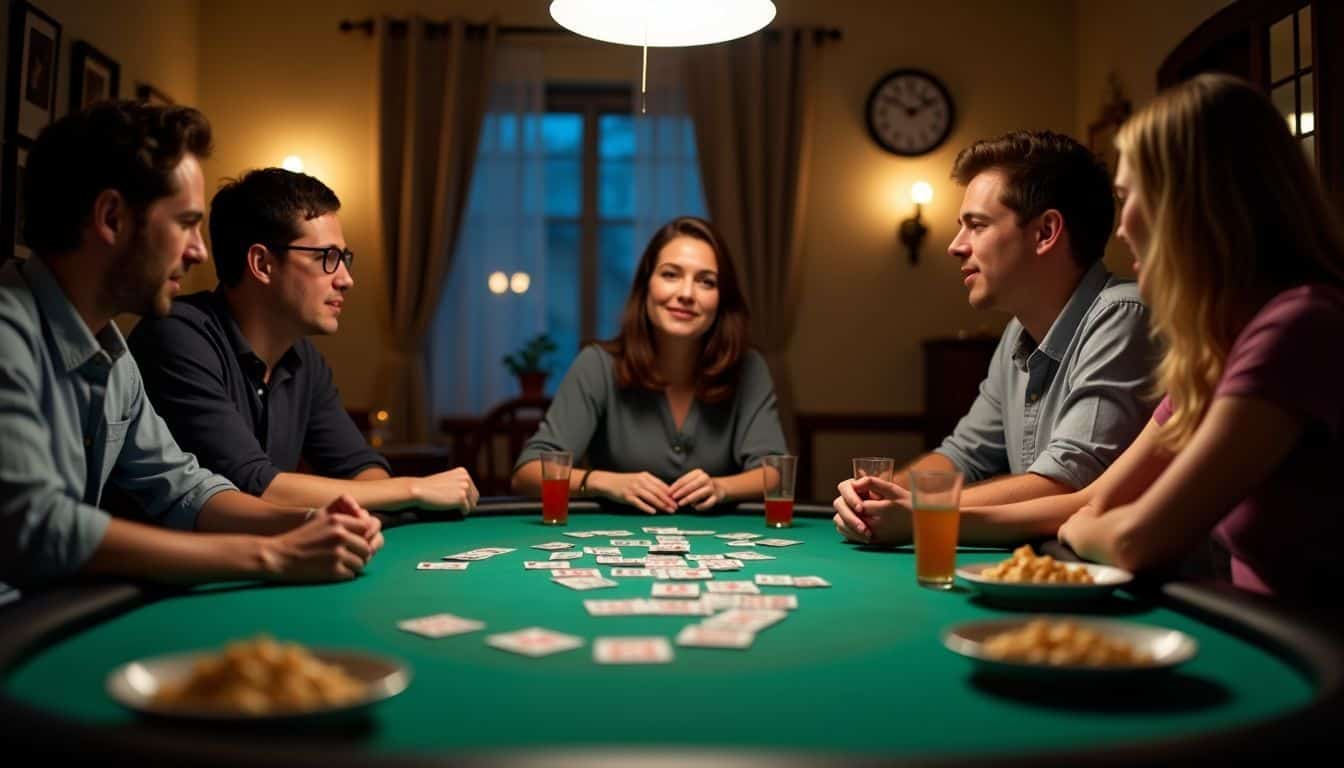
A proper poker night needs a clear finish line, just like any casino. You’ll want to pick a firm end time and stick to it like a pro mixologist follows their recipe measurements – this keeps everyone happy and ready for the next game night.
Set an End Time
Every great poker night needs a finish line. I learned this the hard way after hosting games that dragged into the early morning hours. Your guests will play better and have more fun if you pick a clear end time, like 11 PM or midnight.
Most casino poker rooms wrap up their tournaments by midnight to keep players sharp and competitive.
Setting a firm end time helps your guests plan their night and next day. Tell everyone the end time when you send out invites. This keeps the game moving at a good pace and prevents that awkward moment when players start nodding off at the table.
Pro tip: I serve the last round of drinks an hour before wrap-up time. This signals the final stretch and lets everyone focus on those crucial last hands.
Cleanup and Feedback
Once the final hand wraps up, your poker night moves into its last phase. A quick cleanup keeps your space fresh and ready for future games. Stack the chips by color, gather the cards, and wipe down any spills on the table.
Your guests might offer to help – take them up on it! The cleanup becomes a social activity where players share their favorite moments from the night.
Smart hosts know feedback makes future games better. Ask your guests what they loved about the night. Did they enjoy the snacks? Was the music too loud? Their input shapes your next poker party.
My last poker night got rave reviews about the mixologist who crafted custom drinks. The players also suggested adding more comfortable chairs. These small tips led to better games each time.
Your guests will appreciate that you value their thoughts, making them eager to join your next poker night.
People Also Ask
What do I need to know about hosting poker night at home?
For hosting poker night, you’ll need a solid grasp of poker rules, comfy seating, and good lighting. Think like a casino pro – set clear house rules before players arrive. Keep chips and cards ready, and plan your snacks for poker night ahead of time.
What drinks should I serve at my poker night?
Mix it up like pro mixologists! Stock your home bar with basic spirits and mixers. You can even hire a bartending service for a fancy touch. Just remember – keep drinks flowing but watch that players stay sharp enough to play well.
What are the must-have snacks for poker night?
Pick finger foods that won’t mess up the cards. Smart hosts choose easy-to-eat snacks for poker night like nuts, chips, or small sandwiches. Avoid greasy foods that could stain cards or make hands slippery while dealing.
How do I make sure everyone knows the rules of poker?
Before dealing the first hand, go over the rules of poker clearly. Print out a cheat sheet for new players. Make sure everyone understands betting limits and game variations. Good hosts keep the rules simple at first, then add complexity as players get comfortable.
